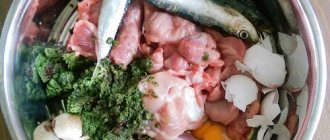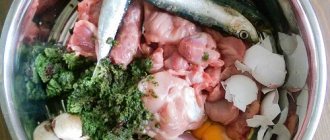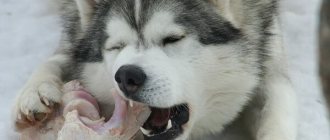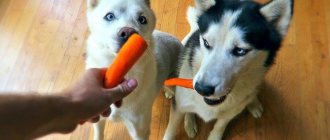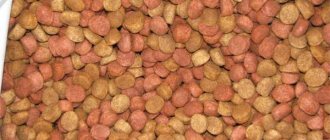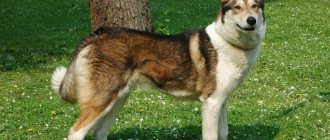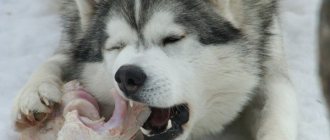Recently, the BARF nutrition system for animals has become increasingly popular among those dog breeders who feed their pets natural food. And this is not only a fashionable trend, but also a desire to find the right approach to feeding a dog, to abandon industrial food, the quality of which in recent years leaves much to be desired and leads to health problems.
When it comes to feeding dogs, their owners are divided into two camps: some are supporters of ready-made industrial food, while others are in favor of a natural diet.
So what is the BARF nutrition system? Who is the founder of this direction? What are the basic principles of this system? Is this food system unconditionally good, or are there risks associated with feeding the products that form its basis?
What is BARF and its history
The history of the BARF food system began in 1993, when the book “Give a Dog a Bone” was published by Australian veterinarian Ian Billinghurst. In his book, the author describes the advantage of feeding dogs raw foods that are close to the natural diet of their wild ancestors (wolves), over industrial foods.
Initially, the abbreviation BARF was interpreted as “bones and raw food” (bones and raw food). Subsequently, it was transformed into “biologically appropriate raw food” (biologically appropriate raw food).
Ian Billinghurst claims that as a result of many years of observation, he found that dogs eating industrial food live much shorter than their counterparts eating raw natural food.
The basic principles of Ian Billinghurst's theory are:
- The dog is a carnivore with strong teeth designed for tearing food and chewing bones, and a digestive tract capable of digesting raw animal protein.
- The BARF nutrition system does not seek to return domesticated animals to the natural diet of wild ancestors (wolves), but only imitates the principles of nutrition of predators (raw meat, bones, internal organs of prey, fat, eggs, grass and roots), adapting the diet to modern conditions for keeping four-legged animals.
- The goal of the BARF nutrition system is to optimize the health of the animal, increase life expectancy and reproductive abilities through a properly selected diet.
- Industrial food contains many harmful substances and components that cause various diseases in pets: preservatives, flavoring additives and dyes, low-quality products from which these foods are made.
- Ian Billinghurst categorically rejects the addition of cereals to a dog’s diet, believing that the four-legged digestive system is not suitable for digesting grains.
- The author claims that heat-treated foods lose nutrients.
Owners of dogs switched to the BARF system unanimously claim that with the transfer from industrial feed to a raw diet, they began to observe improvements in the condition of their pets: mouth odor and tartar disappear, allergic reactions stop, weight normalizes, problems stop with paraanal glands, constipation, the animal becomes more active.
Disadvantages of nutrition
The disadvantages of the BARF dog feeding system are the danger of an imbalance of nutrients. The fact is that feeding natural food without special additives does not always compensate for all the animal’s needs for vitamins and nutrients.
There are also some problems that relate to eating raw meat. It can contain all sorts of parasites and viruses, such as tapeworms, salmonella and E. coli, to name a few. They cause various diseases in animals. Although supporters of this feeding system argue that only pets with weakened immune systems are at risk. The BARF system strictly prohibits feeding pork to dogs. The danger lies in the high content of the deadly Aujeszky's virus.
The view of veterinarians on the BARF dog feeding system is far from clear. Some argue that it guarantees the animal health and long life, because it is close to natural food. Others point to significant disadvantages. However, such nutrition is one of the possible feeding options. The veterinarian is responsible for making the dog owner aware of the risks. Another significant advantage of this diet is that it costs less money compared to buying professional food. Ultimately the choice is up to the owner.
What is included in the BARF diet?
Let's look at what foods are included in the BARF system diet.
The BARF nutrition system is aimed at the fact that a dog is a predator by nature, which means it should eat approximately the same as its distant ancestors in the wild (raw meat, bones, internal organs of prey, fat, eggs, grass and roots).
The basis of the BARF diet is raw meat and bones
The opinion that a dog should eat only muscle meat is extremely erroneous. But large beef or lamb bones-butter, which are given to dogs for “chewing”, are also not the basis of the meat component of this system.
Meat diet of the BARF system:
- Raw meat (beef, lamb, rabbit, chicken, turkey, horse meat), and the meat must have cartilage, veins and film.
- Meat bones (chicken or turkey wings, necks, carcasses, backs, heads (without beak), ox tails, soft lamb bones, rabbit meat). There should be about 50/50 meat and bones. The main thing is that they must be raw. Read about which bones you can give to your dog and which are strictly prohibited.
- An important part of the meat diet is offal. Offal: raw tripe, offal, trachea, lung, heart, liver, beef trimmings. By-products are a very valuable part of the diet, but due to the fact that they are rich in nutrients and enzymes, it is not recommended to give them every day. How many by-products should be in a four-legged diet, what by-products are recommended for feeding, read the material: What by-products can be given to a dog.
Fish
Fish is an important source of essential amino acids such as Omega-3, Omega-6, and phosphorus. Fish oil has a general strengthening effect on the entire immune system. Proponents of the BARF system also advise eating fish raw.
But personally, I would not risk giving my beloved pet raw fish, since it contains a huge amount of pathogenic bacteria, eggs of all kinds of parasites (including helminths), toxins, heavy metals and pesticides that the fish could receive from contaminated water.
The likelihood of infection with parasites from river fish is much higher than from sea fish. From sea fish, dogs are usually given pollock, cod, hake, haddock, and blue whiting.
Vegetables
In addition to meat products, the animal’s diet must include vegetables. Vegetables should also be raw. Vegetables should be varied, both “tops” and “roots”.
Vegetables can be given in any quantity: carrots, zucchini, pumpkin, broccoli and cauliflower, bell peppers, spinach, cucumber. Cabbage, tomatoes and green beans can be given in moderation.
The author of the nutritional system claims that vegetables must be crushed to a puree state, since the animal’s body is not able to digest fiber. Plus, he refers to the fact that in the wild, for the most part, wild ancestors obtained plant food by eating the remains of the stomach of herbivorous prey. And there the grass was already semi-digested, crushed and fermented.
Greenery
Herbs and roots in the diet should include: lettuce, dill, parsley, dandelion, nettle, seaweed (they can be bought at the pharmacy and added to food).
Fruits and berries
Fruits are not an obligatory part of the BARF diet, but they diversify it, providing the body with useful microelements, and simply bring pleasure to the pet.
Fruits you can give your dog: apples, pears, watermelon, blueberries, blueberries, lingonberries, banana.
Dairy products
Fermented milk products are very useful: cottage cheese, yogurt, sour cream, kefir, yogurt. You can read more about which dairy products you can and shouldn’t give your pet in the article: Can dogs have milk?
Eggs
It is recommended to give raw eggs to dogs no more than 1-2 times a week. If they are quail, then you can have 2 pieces at a time. If chicken, then one at a time and it’s best if it’s a yolk. In addition, it is very useful for dogs to feed quail egg shells - it is an irreplaceable source of calcium, magnesium, phosphorus and sulfur. Calcium is very useful for joints and bones, but phosphorus and sulfur are for wool.
Supplements
In addition, Dr. Billinghurst recommends including various oils in your pet’s diet: olive, flaxseed, burdock. Cod liver oil or just fish oil for dogs, seaweed (without additives), vitamins B, C and E, bran.
Since the BARF nutrition system is aimed at consuming bones, oils soften stools well and help food pass easily through the intestines.
Dr. Billinghurst advises not to treat your dog's daily diet with special delicacy, measuring every portion, every product down to the gram. It is not necessary that every dish be balanced and have all the nutritional elements present. It is important that the dog as a whole receives all the products necessary for its health.
Not every dish can be balanced; what is important is what your pet will receive in total during the week, and not at each meal.
Myths
Adherents of this style of eating often tell a lot of information, much of which is similar to modern legends. Sometimes this is true, so let's try to dispel at least the most popular ones.
Cereals
The ban on their use is justified by the fact that in the wild, wolves do not eat cereals. They are also said to cause severe allergic reactions. However, in fact, there is no scientific evidence to support these theories, and a moderate amount of unprocessed cereals cannot do any harm, but will only help compensate for the lack of carbohydrates.
Heat treatment
On some level, this ban makes sense, but meat and fish are a different story. In their raw form, they may contain various pathogens, viruses, helminths and other nasty things. Therefore, sometimes it makes sense to lightly boil them to protect your pet. It is worth noting that all SUPERPET products are subjected to shock freezing. This allows you to destroy parasites, as well as preserve a maximum of vitamins and beneficial microelements.
How to calculate the amount of food based on the dog’s diet and age
If we consider it as a percentage, then from the entire daily diet an adult dog should receive:
- 60-70% - meat (15% of which is by-products).
- 15-20% – vegetables and herbs.
- 15-20% – eggs and dairy products.
But this is for adult dogs. For small puppies, a slightly different scheme applies here. At a young age, the main component in a dog’s diet is still dairy products. You can read more about this here: How to properly feed a puppy from one month to a year.
The daily feeding rate, according to the BARF system, should be 2-3% of the weight of an adult animal. That is, if your pet weighs 10 kg, then he should eat 200-300 grams of raw food per day. Based on the percentage given above, for an adult animal weighing 10 kg per day it is necessary:
- 120 - 180 grams of meat (of which 50 are 50% meat and bones, and about 10 - 15% offal).
- 30 – 60 grams of vegetables, herbs and fruits.
- 30 – 60 grams come from eggs and fermented milk products.
But this is all approximate. Each dog owner must regulate the amount of food your pet consumes.
For dogs with increased activity, the diet can be increased to 5%. Growing puppies and adolescents require even more - about 5-10% of the daily portion, based on the animal's weight.
Next, you should divide the amount of daily food consumed by the number of feedings, and you will get the approximate value of one serving.
For example, if you feed your pet weighing 10 kg 2 times a day, then the weight of one serving should be: 100-150 grams.
But again, I repeat, everything is individual. If you notice that your dog is thin, increase the meat component of the diet. If, on the contrary, the tail has become overfed, then reduce the meat and increase the vegetable component of the diet.
Smart transition
There are two main options that need to be considered in a little more detail. The choice should be influenced by the following factors:
- Age.
- Health status.
- Previous version of the diet.
Fast
Suitable for those who already eat natural food; according to the BARF system, then you just need to introduce raw, unprocessed foods. At the same time, the serving size of prepared food is reduced and in about 2-4 days you can simply move on to the selected menu.
Slow
This is more suitable for animals that previously ate exclusively industrially produced food, especially when it comes to dry options. This process should last much longer, at least 10-15 days. Also suitable for sick, weakened and elderly pets.
Veterinarians recommend giving medications during the transfer to speed up digestion and support the liver, and then stop taking them when finished. More detailed instructions for a gentle transition can be found on SUPERPET. Regarding specific medications, it is better to consult a good specialist.
Transition to the BARF system
There are 2 methods of transitioning a dog to a raw diet: fast and slow. The choice of method depends on what your pet ate before, its age and health.
Fast passage
A quick transition is when yesterday the dog ate commercial food or home-cooked natural food, and today you offer it raw BARF diet products.
If the animal has previously been accustomed to boiled or raw home-cooked food, if the dog is young and healthy, then a quick transition to BARF should go almost unnoticed.
If, after trying natural food, your tail categorically refuses dry food, what can you do, you will have to act according to a quick scheme. But in this case, when switching to a raw diet, experts recommend giving the four-legged dog a short one-day fast.
Slow transition
Ideally, the transition to any new food system should be carried out gradually, otherwise a sudden change in diet can lead to diseases of the gastrointestinal tract. This is especially true for those dogs that eat industrial food.
And all this is due to the following factors:
- When eating industrial feed, the activity of the pancreas decreases. Processing such feed does not require much effort. But when feeding natural products, the stomach needs to secrete a sufficient amount of concentrated gastric juice to process them. If you start feeding your pet natural food immediately after dry food, the stomach will need a lot of effort to restore full function. And this is fraught with disorders and gastritis.
- For dogs fed commercial food, a new diet may initially be traumatic for the digestive tract.
Therefore, if your pet, having tried natural food, does not “turn up its nose” at dry food, then it is still best to switch to a natural BARF diet according to a slow scheme. You can find a scheme for the gradual transfer from dry to natural feeding in the article: How to switch a dog to natural food.
Important rules to follow when switching to BARF
- Introduce new products gradually, one after another, in small quantities (can be combined with familiar products). This is necessary in order to make sure that the animal’s body tolerates the new product well and is not allergic to it.
- At first, control the feeding process, and sometimes even teach the dog to eat properly. Many dogs raised on commercial food do not know how to properly chew natural food, drag it around the floor, or, conversely, greedily swallow too large pieces and bones. Such dogs need to be fed by hand (without giving away, for example, a wing right away) until the pet learns to chew food correctly. Puppies raised on a BARF diet from an early age do not have such problems.
- Don’t test the strength of your dog’s stomach; help the animal adapt to new food. To do this, when switching to a new food system, be sure to give the dog a prebiotic (for example, Hilak Forte) half an hour before meals. Before giving your dog a bowl of food, sprinkle the finished dish with a probiotic such as Bifidum Bakterin. In addition to this set, which normalizes the intestinal microflora, Karsil is supposed to be given. Probiotics and bifidobacteria help restore the body's microflora. Once you have completely switched your four-legged dog to a new diet, supplements should be excluded from the menu. Probiotics should not be given to healthy pets on a regular basis. A dog needs a balanced diet, which already includes natural probiotics, which are present in fermented milk products and rumen.
Where to start
In the first few days, Barfists recommend feeding your pet exclusively according to this scheme:
- Morning feeding: Hilak Forte 30 minutes before meals, chicken necks (without skin) sprinkled with Bifidum Bakterin + Karsil.
- Evening feeding: Hilak Forte 30 minutes before meals, chicken wings (without sharp tips) sprinkled with Bifidum Bakterin + Karsil.
Only after 3-4 days, exclusively according to this scheme, is it recommended to begin introducing new products one at a time, in addition to the necks and wings. If, after the next addition of a new component, the dog shows signs of an allergy, the new product should be excluded from the menu.
Pros of nutrition
The BARF dog feeding system has quite a lot of advantages. A balanced diet based on fresh foods helps improve the condition:
- teeth;
- wool;
- skin.
In dogs, tartar and bad breath disappear, and their weight returns to normal. Owners note that their pets have become much more resilient and active. The BARF dog feeding system has other advantages: the animals on which it is used are not obese. Their neck and mouth muscles develop well. With the right selection of products, the functioning of the gastrointestinal tract improves and problems with constipation disappear.
LOTS of delicious recipes prepared using the Barf system
And now there are many delicious and healthy recipes from Diana Smetanina and her wonderful, kind and affectionate handsome Yashenka.
Let your dogs eat tasty and healthy food, and then they will always be as happy and contented as Yasha!
1. Turkey hearts, stewed pear from the garden, cranberries, an egg with an orange yolk, parsley.
2. Beef trim without fat, stewed zucchini and whole green beans, egg, Polydex vitamins, dry beef lung.
3. Sea whiting fish, fresh cabbage, cherry tomatoes, parsley, egg, sunflower oil.
4. Turkey escalope, boiled peas, raw bell pepper, egg, fermented baked milk 3.2%, Polydex vitamins.
5. Bull nose (with cartilage), scalded potatoes, Titbit cookies with lamb, egg.
6. Blue whiting, egg, carrots, parsley and seaweed.
7. Medium quality beef trimmings, raw pumpkin, last and for some reason boiled egg, Polydex vitamins, cranberries.
8. Turkey liver, neck, chicken egg, pumpkin with seeds.
9. Turkey gizzards, grated green apple, blueberries, egg.
10. Beef, zucchini, egg, dill and some brains for my favorite Scarecrow.
11. Cottage cheese 9%, kefir, apple, blueberry, lingonberry, egg with selenium.
12. Pollock, egg, green beans.
13. Beef trimmings, duck necks, duck skin, egg, dill, sunflower oil.
14. Duck necks, turkey fillet, duck skin, apple, sunflower oil, egg.
15. Duck gizzards, lean pork, salad, egg.
16. Trimmings from chicken thighs, beaked chicken heads, frozen pumpkin with seeds, quail eggs with shells.
17. Duck necks, chicken thigh, beef trimmings, carrots, sunflower oil.
18. Chicken fillet, chicken frame, green beans, egg.
19. Duck stomachs, chicken necks, pumpkin.
20. Duck liver, chicken necks, chicken thigh, cucumber, dill.
21. Beef liver, chicken necks, tomato, chicken egg.
22. Beef trachea, spleen, tongue, pumpkin.
23. Beef heart, lung, spleen, kidneys, chicken necks, Chinese cabbage.
24. Cottage cheese 5%, pumpkin core, egg, kefir 3.2%.
25. Turkey escalope, bell pepper, sour cream, egg, butter, Polydex vitamins.
26. Beef tripe, dill, parsley, vegetable oil.
27. Beef spleen, beef tongue, bell pepper, vegetable oil.
28. Chicken stomachs, vegetable oil, carrots, dill, parsley, chicken egg.
29. Chicken liver, sour cream, vegetable oil, rye bran.
30. Beef intestines, cream cheese, nuts.
31. Chicken liver, chicken thigh, excess apple, which I cut into salad, dill, parsley, vegetable oil.
32. Chicken backs, cucumber, buckwheat flakes, vegetable oil.
33. Beef, beef trachea, chicken egg, oatmeal.
34. Cottage cheese, a chicken egg, a strawberry found in the freezer, frozen from the summer.
35. Beef spleen, beef trachea, scalded potatoes (of course, not sweet potatoes, but still), chicken egg, vegetable oil.
36. Duck head, neck, wings, legs, heart, stomach, liver, buckwheat. Back to the roots is simple!
37. Chicken, lingonberry, egg, vegetable. Oil.
38. When you have borscht for dinner, a bowl of fiber looks like this: cabbage, carrots, beets, herbs, vegetable oil, sour cream, beef, chicken necks.
39. Cottage cheese, muesli, kefir, linden honey, apple, banana, Polydex vitamins.
40. Chopped chicken parts, cranberries, lettuce, bran, Polydex vitamins.
41. Cottage cheese 5%, fresh grated raw carrots, sour cream 15% 1 tbsp. spoon (for a medium-large dog), raw fresh whole chicken egg.
42. Turkey liver, scalded white cabbage, sesame seeds (preferably chopped).
43. Turkey escalope, neck, carrots, Parsley, sunflower oil.
44. Chicken stomachs, grated zucchini, cauliflower, whole quail eggs, a little vegetable oil.
Thank you very much to Diana and Yashenka for sharing their delicious and healthy recipes with us!!!
It is important to know!!!
Not all BARF diets are equally suitable for all dogs. Any feeding method must be individual and selected based on the breed, age, weight, structure and health of the dog.
Currently, the main source of information about the BARF food system is the Internet. After reading the forums, animal owners rush headlong into the pool and begin to experiment sharply on their four-legged animals. And often this does not bring benefit, but actual harm, because not every dog’s body is able to digest certain bones.
Honestly, I really like the BARF nutrition method. We also feed Jack natural food, and his entire diet is very similar to the BARF diet. You could even say that they are almost identical, with a few exceptions:
- Dzhekusik's diet contains a small amount of boiled cereals (about 10% of the daily value).
- I do not serve meat and fish raw, but boil them for about 10-15 minutes. The only exceptions are tripe, trachea, beef or lamb meat, which I give raw, but previously frozen.
- Any bones are excluded from our diet. Unless, again, the same whole beef or lamb bones, which cannot be chewed and hurt the mouth, and which I pass off exclusively as a tasty chew.
- I don’t chop or puree vegetables, but cut them into cubes and add them raw to food. I believe that chewing vegetables also prevents the formation of plaque.
These are, perhaps, all the differences between Jack and I’s nutritional system and the BARF system’s diet.
Expressing my purely subjective opinion, I believe that in this way I protect Jack as much as possible from possible risks.
What foods should you not give to your cat?
Pork and game, if their sources are unknown, for example, due to the possibility of Aujeszky's disease.
Some plant foods should be completely excluded from the diet, including raisins and grapes (they damage the kidneys and can kill the animal), avocados, beans, rhubarb, garlic, onions and other onion vegetables, peaches, and apricots. Apples can be given, but only without seeds. If the cat refuses to eat bones, they should be replaced with a calcium supplement or crushed eggshells (at the rate of 2 teaspoons per 1 kg of meat).
Cat owners should carefully monitor the amount of liver they eat, as they contain a lot of vitamin A, and its excess is very harmful. Liver cannot account for more than 5% of the daily portion!
A mandatory supplement is taurine; its deficiency leads to heart disease, visual impairment, and, in young animals, to insufficient development of the brain and nervous system.
Risks associated with BARF feeding
I fully support the point of view that it is better to feed your pet fresh and high-quality products than food with unknown contents, the quality of which is questionable for me personally, and you can only blindly believe the manufacturer’s advertising.
But often, pet owners, obsessed with the idea of food intolerance and the dangers of industrial food, do not take into account other risks that may lie in wait for them when eating a raw food diet.
Despite the undoubted benefits, the BARF nutrition system has certain risks. Therefore, before introducing a particular product into the diet, it is important to carefully analyze whether your pet is able to consume it without harm to health.
Here are some risks that may “lurk” for animals and their owners when feeding using this system.
Problems with eating bones
Chewing tough pieces of meat and bones helps remove plaque from teeth and prevents the formation of tartar in dogs. But on the other hand, eating bones carries the following dangers:
- Injuries to the oral cavity.
- Tooth fractures.
- Bone stuck in the esophagus and intestines.
- Intestinal obstruction and constipation.
Of course, there is no exact information about the direct causal connection between the growth of this problem and nutrition according to the BARF system. But according to veterinary clinics, the above cases have begun to occur much more frequently in the last few years.
The author of the BARF system, like many of his followers, claim that raw tubular bones from bird wings are not capable of harming the animal. But we can only partially agree with this. It all depends on the size of the dog and the ability of its gastrointestinal tract to digest such bones. It is quite possible that a large dog with powerful teeth can easily chew and digest such food, but a small dog with a tail is unlikely to be able to do this without harm to health.
Hygiene and quality of raw products
Responsibility for monitoring the quality and composition of products consumed by the dog lies entirely with the owner of the animal.
The main risk of eating raw meat is that raw meat may contain viruses, bacteria and parasites. In most cases, we buy meat by-products for our pets at markets, because you are unlikely to find unpeeled beef tripe for dogs in stores, which, by the way, is very healthy for pets. And often, when transporting meat, all hygiene rules are not fully observed. It is unlikely that all containers are disinfected after each shipment. Residues of meat products left on the walls of the container can rot and decompose, forming toxins and parasites that can be transferred to the next transported batch.
All raw meat is potentially dangerous if basic hygiene is not followed when preparing it. One of them is a minimum 3-day freeze.
In the modern world, products intended for humans are mostly harmless. Before hitting store shelves, they all undergo a thorough sanitary check. Plus, we do not eat raw animal protein. But if you feed your pet unprocessed raw meat, then there is a huge risk of contracting from your pet salmonella, E. coli, or even a disease such as tuberculosis, which the animal does not suffer from, but is a carrier of this disease.
A greater danger than meat is posed by raw fish, namely parasites, which can cause serious illnesses in your pet. In addition to parasites, toxic substances can accumulate in fish if they lived in polluted water. Eating raw fish also poses a risk of poisoning from pesticides or heavy metals. If the fish is infected, then with proper heat treatment, the parasites die.
Chicken, as one of the main nutritional components of the BARF system, is a strong allergen for animals that have even a slight hint of food allergy. To ensure rapid growth in poultry farms, chickens are fed various additives, antibiotics and other chemicals. The skin from chicken wings is quite oily and can harm the liver if consumed frequently. Of course, if your pet does not have allergies and digests raw bones well, then chicken can be a good addition and diversify the diet. Read more about whether or not you can feed your dog chicken.
Detoxification
Some materials from the BARF nutrition system indicate that when switching from industrial feed to a raw food diet, the animal may experience skin rashes and digestive disorders. This phenomenon is called detoxification (removal from the body of harmful substances that have accumulated there due to feeding on industrial feed).
And very often, when switching to this food system, and encountering such side effects, animal owners think that all these disorders are detoxification. However, very often indigestion and skin problems can be nothing more than intolerance to certain foods or allergies.
Risks
When switching to BARF, many owners do not take into account a number of risks that exist. Evaluate them and protect your pet, albeit with minor deviations from the classic diet.
Problems with teeth and gums
When gnawing on thin tubular bones, fragments with sharp bones are formed. These are mainly the bones of the legs and wings of birds, which are included in large quantities in BARF. If these fragments enter the digestive system, they can injure the esophagus, stomach, and intestines. Moreover, the bone may get stuck and will have to be removed by a veterinarian. If you give bones to your dog, it is better to limit yourself to large bones that are difficult to chew.
Damage to teeth and gums
When actively gnawing on bones and chewing tough meat, there is a risk of damage to teeth and injury to gums. Inspect your animal's mouth regularly. If wounds and damage are found, contact your veterinarian and remove hard foods.
Regularly inspect your animal's mouth for damage and wounds.
Nutrient Imbalance
BARF nutrition is poorly balanced in terms of vitamin and mineral components. If minerals tend to accumulate and be consumed gradually, then vitamins must be supplied in the required quantities daily. With their irregular and insufficient intake, health problems appear. To avoid this problem, include ready-made vitamin-mineral complexes in your menu and balance your diet.
Quality of raw ingredients
It is unknown what conditions there were during the storage and transportation of market products. Especially the group of meat products “for dogs”. In addition, raw meat and fish contain viruses and helminths.
For healthier and safer feeding, eliminate poultry bones. Do not serve meat and fish raw, but cook for 10-15 minutes.
Myths associated with the BARF system
There are some points in the BARF nutrition system in which the author categorically rejects certain products. While claiming that some components are harmful or insufficiently beneficial, the author does not provide detailed reports on the research conducted. He simply lists them as unquestionable postulates. However, you may not agree with some of them. Below are some of the benefits cited by proponents of the BARF system, with comments from a veterinarian.
Avoiding grain products
The author claims that the digestive system of animals is not adapted to digest cereals, since they contain gluten.
The idea that gluten and grains are harmful to animals is one of the popular claims lately that has no scientific basis. Gluten-containing foods should be avoided by both humans and animals unless gluten intolerance exists, which is extremely rare. And over many years of evolution, the digestive system of animals has learned to fully process carbohydrate products.
For example, rice, which is often included in the diet of dogs, contains about 8% protein, some fat, carbohydrates and does not contain gluten at all.
Heat treatment is harmful to food
Proponents of raw feeding argue that feeding cooked meats leads to protein enzyme deficiencies.
In fact, the total loss of the most valuable component of meat - protein, during heat treatment is only 2-7%. But even this percentage can be reduced if, when cooking meat, you put it in boiling water. The main destruction during cooking occurs in the amino acids contained in the meat. But, as practice shows, all amino acids can be easily replenished by including cottage cheese, sour cream, and eggs in the animal’s diet.
Undoubtedly, all products of the BARF diet are much better digested than low-quality industrial feeds. However, heat treatment of products does not in any way affect the digestibility of meat by the four-legged body. Thermally cooked foods are easily digested and do not impair the quality of the animal's stool.
Reasons for the transition
Many owners often decide to switch to a new system because it may look more natural, and in order to switch their pet to a healthy and high-quality food. Moreover, the main motivating factor is the information that all industrial feeds are based on harmful chemical additives, as well as low-quality or spoiled raw materials, which is harmful to their health. However, this is not always true, and there are many different brands on the market that have never been noticed in such fraud.
The second significant reason can be considered the emergence of various health problems, which can hardly be avoided over the years, the development of chronic diseases and pathological conditions. The most common among them are the following:
- Problems with the epidermis.
- Diseases of the gastrointestinal tract.
- Excess body weight.
- Allergic reactions to food components, as well as other substances.
- Problems with wool.
Many owners who have already switched to such feeding claim that they have found a universal solution to almost all the most common problems. Such people receive the main part of their information from popular online videos, brochures and books, which are actually based more on emotions than on scientific data. Therefore, it makes sense to approach the issue more rationally, because this is just a diet, and not a panacea for all diseases.
BARF feeding system to help dog breeders
People started talking about the BARF diet relatively recently, but many breeders and veterinarians have already appreciated its advantages.
The history of the appearance of this food system is associated with the name of the Australian veterinarian Ian Billinghurst, who described it in the book “Give Your Dog a Bone.” But most pet owners are completely unaware of the extraordinary benefits of raw food for dogs. And even after reading the book, questions remain. And we shouldn’t forget about the psychological factor, because how tempting it is to grab a bag of dry food from the shelf in the grocery store, and it’s stored for a long time, and there’s no need to cook it. And of course, the power of advertising, when statements about “the healthiest” or “the meatiest” are pouring out from the screens.
We emphasize that BARF is one of the diets, it has its advantages and disadvantages, and may not be suitable specifically for your dog. And therefore, before deciding to switch to this power system, you still need to have a good understanding of how it works.
Example of food for an adult dog weighing 20 kg
400 g meat part
- chicken wings 150 g
- stewed turkey 200 g
- chicken stomach and liver 50 g
40 g vegetable part
- carrots, apple, parsley, broccoli, strawberries (different proportions mixed together)
supplements
- yeast 2 g
- 2 tsp salmon oil
- seaweed 2 g
- 1 whole chicken egg
Benefits of the BARF Diet
The BARF diet for dogs makes them have a stronger and healthier immune system . Some followers of the diet say that all this leads to other benefits for the animal, such as:
- Reducing allergies and other diseases..
- Increasing physical activity...
- Cools your breath and cleans your teeth.
- Reduce fat and improve strength..
- Bright skin.
- The dog will love it, especially if it provides a variety of food, all of which should be natural and fresh...
to the entry “Advantages of the BARF dog nutrition system, weekly feeding menu”
Do you mean you can’t give it raw if the entire Barf system is built on raw food? Based on the same system, dogs are not allowed to eat cereals. So why do you misinterpret and sign that this is the Barf system?
Hello! The BARF system is truly raw food, which is what this article is about. Everything is just raw! Cereals were not mentioned in the text; they are not included in this system. Do I understand correctly what you mean by video? But we are talking about natural nutrition, not about the BARF system specifically. There are intersections. We will try to find a suitable video on the topic as soon as possible. Thank you for reading us)
Source
Raw feeding recipes
BARF system for dogs - menu for the week:
The BARF nutrition system provides the dog with everything necessary. But it is possible that your dog requires additional vitamins or minerals due to illness or pregnancy. Therefore, it is worth consulting with your doctor to find out whether your dog needs additional vitamins and nutritional supplements.
